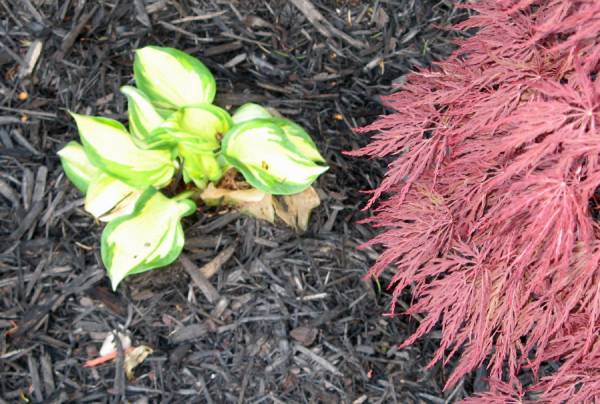Use Black Mulch to Brighten Up Shady Areas
May 12th, 2008
Mulch comes in many colors, people have long been using the ever present red mulch, and in fact I would venture it probably rivals plain mulch in volume. There are also golden mulches, that look like very fresh wood. Then there are more subdued brown mulches that look like slightly older wood.
The main advertised benefit of colored mulches is that they keep their color and so you don’t need to replace them as often. Personally, that doesn’t fly with me. I don’t lay down new mulch for coloring reasons, I do it to maintain a good thickness of 2-3 inches.
I do, however, use colored mulches sometimes in some places. I use them for their colors, as just another design element. You might plant a purple smokebush around some golden variegated hostas and it would look good with the foliage colors contrasting. You can achieve the same thing, and do more, by adding colored much into the area. So now you can contrast the plants against each other, and the mulch.
You can also contrast mulch with itself. My raised asparagus beds are covered in red mulch, and the ground level beds surrounding them are covered in gold mulch. It works.
This post though, this post is about black mulch, the post title I’m sure seems impossible. How could someone as dark as black brighten up a shady area? But what have I been discussing so far? Contrast. So, lets discuss contrast and shade.
Most flowering plants that do well in shady environments produce lackluster flowers, or atleast those that cannot compete with their sun loving cousins. In contrast (ahem), the foliage of plants that do well in shady areas tends to be spectacularly colorful with shades of golds and reds and blues, and of course greens.
However, foliage rarely rivals flowers for color, so make it pop, you need contrast. The most popular way to get contrast is to put clashing plants next to each other. A red-green plant looks crimson when planted next to a yellow-green plant (which itself ends up looking bright). Contrast helps to highlight the differences between the plants, making both look brighter and more vibrant.
So, since black is the ultimate contrast creator, adding black mulch to your shady areas might just brighten them up when paired with lighter colored plants.
Give it a try. I did, and as you can see in the picture (which by the way is Hosta ‘Great Expectations’ underneath my red laceleaf Japanese maple), I think it works.

May 13th, 2008 at 9:06 am
An interesting article – gives me lots of ideas. Never thought of using colored mulches but it makes sense.
May 14th, 2008 at 1:10 am
Great post!
I used some new mulch around my ‘moses in the cradle’ plants. I’ve planted them in a row against the neighbors fence (dark brown painted brick) covered the ground with a light yellow / white decomposed granite mulch.
The green & purple against the brown, then highlighted by the white makes for a really classy formal look.
May 17th, 2008 at 1:35 pm
what acreative ideas . lt has not occured to me to do that.
May 19th, 2008 at 6:05 am
I like the idea of using different colors to accent your plants. My only concern would be how they make the mulch black, or red for that matter. My presumption is that it is innocuous. But you never know.
If you want a really great mulching medium, try shredded leaves. It does far more than your usual mulch.
cheers
June 27th, 2008 at 5:45 pm
I like the contrast that it creates.
July 20th, 2008 at 4:02 pm
I too was a huge fan of the black mulch and the rich look it gave my garden initially….However, beware these mulches are made of dyed new woods (sometimes even from old pallets that have been chopped up) vs aged woods. When using this product be aware that you will need to pay very close attention to your fertilization as they tend to “rob” to soil of it’s nutrients as the bacteria that would normally be found in the aged mulches and would work in the soils enrichment are now putting their energies into the breakdown and decomposition of this new wood…..so even though it is pretty, the dyed mulch can be very detrimental to your garden. I learned the hard way and almost destroyed my garden….
October 10th, 2008 at 4:26 am
I am looking for Purple & Gold (LSU) mulch for my garden for a party in November. Do you sell it & ship it.
Josie
March 11th, 2009 at 4:56 pm
In years past i have always mulched both my raised beds and path ways with red mulch. Natural stones seperated the beds from the pathways. This year i got the bringht idea to do the pathways black mulch and the beds raised… I have 15 black bags down on the path ways and dont like it… (picture a black carpet with leafs on it )any ideas?
July 19th, 2009 at 12:55 pm
Can anyone tell me if it is harmful to use black (dyed) mulch in a vegetable garden? In other words can the dye be toxic to the vegetables you are growing?
July 19th, 2009 at 2:41 pm
the dye used on mulch is nontoxic and biodegradable.
September 1st, 2009 at 1:14 pm
Hi,
I was glad to find your website and that you handle black mulch. Do you sell and ship it? and how much is it?
Memory Troudt
May 31st, 2010 at 6:49 am
The black mulch really makes the color of the plants pop. I use it around the house since we have black shutters. Thanks for the info